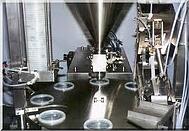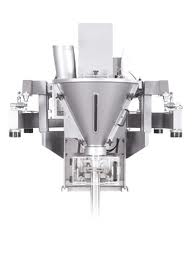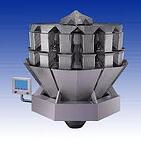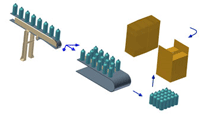Integrating Filling / Dosing Systems
VFFS Machines can be integrated with filling and dosing systems like the following:
Volumetric Cup Filler
Dependent on time and gravity a volumetric cup filler is a series of tubes/cups with a set volume attached to a rotating plate. Suitable for dry and consistent products such as grain, sugar, pet foods, detergents

Auger Weigher
An auger weigher measures the product dosing volume using a screw-like auger for a perdetermined number of revolutions to displace product from hopper to pouches. Applications for an auger are whole-beans or powders

Multi-Head Weighers
Multi-Head Weighers technology is when product is fed into weigh buckets and then it's control system calculates the best weigh bucket combination then discharges. This method of weighing has high precision and accuracy. Most suitable for candy, cereals, IQF foods

______________________________________________________________________________________________
Vertical Form Fill and Seal Jaw Technology
Vertical Form Fill and Seal Jaw Technology is very important as this is the main element when constructing you pillow, side gusseted or flat bottom pouch. The most important sealing function is your cross (sealing) jaws and understanding this process is critical when using Vertical Form fill and Seal technology.
Cross (Sealing) Jaws
The cross jaw is responsible for three major functions—to seal the top of the previously filled bag, to create the bottom seal for the soon to be filled bag and to cut or separate the completed bag from the bottom of the new bag.
The front and back cross jaws operate as a pair. The front and back jaw will both have a top seal area (horizontally) and a bottom seal area. Additionally, either the front (typically due to maintenance reasons) or the back jaw set will have a knife which runs horizontally in the middle of the jaw face. This knife is recessed and is activated by a pneumatic actuator. The opposite jaw set will contain the anvil for the knife.
Each jaw will have one or two heating elements as well as a thermocouple for temperature control. Additionally, the cross jaw section can have options like product wipers, bag deflators, bag hanger punch, gusset (single & double) creation mechanics and flat bottom bag mechanics to name a few. Cross jaws are typically configured mechanically where the front and back jaws interpose each other and therefore meet in the vertical centerline of the bag and forming tunnel. However, there are also versions where either the front or back jaw is stationary and the opposite jaw is moveable. Servo drive/motor combinations, VFD drives with induction motors and high power pneumatic cylinder actuators are used to close the jaws and provide the necessary sealing pressure to provide a suitable bag seal. It is very common for the jaws to contain built-in springs to allow for some closure error as well as a default force. Often, position and torque data are monitored for the cross jaws. This data can easily be used to detect product in the seal or between the jaws. Anytime there is product in the seal, these two bags should be discarded due to potential seal / seam leakage.
The previous sections are typical for an intermittent VFFS machine; however a continuous machine will often contain a section called the rotary or vertical jaw, depending on the bagger type.
_______________________________________________________________________________________________________
Bottom Load Case Packing
 Popular in the publishing and dairy industries, bottom loading requires the advance preparation and collation of the entire case load while a case is registered and staged above the product.
Popular in the publishing and dairy industries, bottom loading requires the advance preparation and collation of the entire case load while a case is registered and staged above the product.
Limited to a maximum of fifteen cases per minute, many of the traditional applications for this technology have been converted to one of the more modern and popular alternatives.
_______________________________________________________________________________________________________



